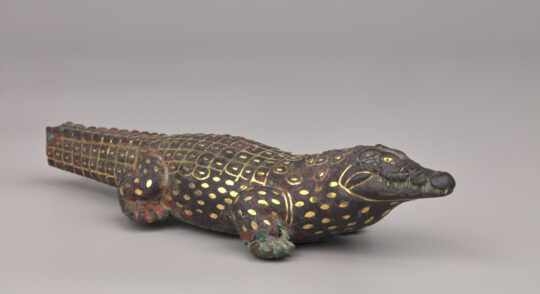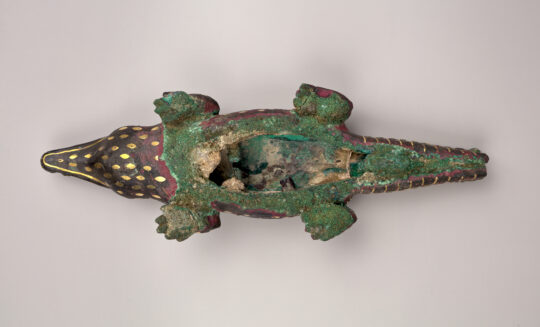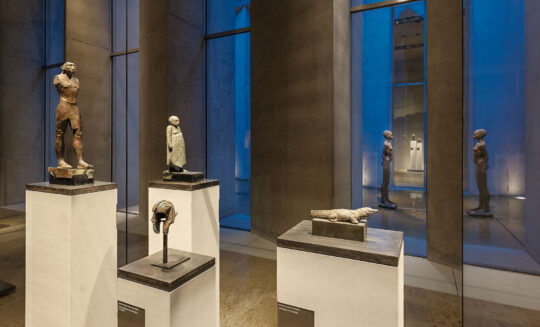23.05.2025
Snappy!
 © SMÄK, R. Hessing
© SMÄK, R. HessingThis small cult statue in the shape of a crocodile may be the earliest example for the manufacturing of “black copper” in Egypt itself. Its age is derived from the other objects it was found with, which depict Pharaoh Amenemhat III of the Middle Kingdom; together with stylistic clues, this puts the date at ca. 1850 BCE. However, “black copper” is not mentioned in the written documents until 400 years later: the military annals of Pharaoh Thutmosis III in the Temple of Karnak mention “black copper” as loot or tribute from the Near East.
The troughs for the decorative elements out of electrum (a gold/silver alloy) were incorporated into the mould itself. Once cast, the electrum wire was inlaid using a process known as damascening, giving the divine statuette its unique appearance. The somewhat abstracted, almost geometric plating on its back, the softer, rounder belly scales as well as the other detailing on the head and limbs stand out in striking contrast to the darker tone of the body. Analysis of the material of the body have revealed the presence of elements typical for “black copper” alloy: gold, silver and arsenic. The crocodile still has its patina, ranging from dark purple to black.
The god is shown in purely animal form. The angle of its powerful legs, turned forwards, and the upward tilt of its head add dynamism to its pose – this is not an animal at rest, but one alert and attentive to its surroundings.
 © SMÄK, R. Hessing
© SMÄK, R. Hessing © SMÄK, Foto: Claus Rammel
© SMÄK, Foto: Claus RammelIn Ancient Egypt, crocodiles were a fact of life: in Antiquity, they still roamed the Nile, a daily threat to people and livestock. It is therefore hardly surprising that, ever since the beginning of Pharaonic culture in the 4th millennium BCE, divine beings in crocodile form played an important part in Egyptian religious thought. Especially in the marshy Fayum oasis, an ideal habitat for crocodiles, we find temple complexes primarily dedicated to a crocodile-shaped god. However, crocodile deities can be found throughout the land, for example in the Upper Egyptian village of Kom Ombo. Sobek is one the best-known crocodile-shaped gods, playing an important role in the Egyptian pantheon as a god of water and fertility. Sacred crocodiles were kept in pools within the temples and, after their death, score of them were mummified and buried in dedicated animal necropolises.
The Munich crocodile was found in a cache in the Fayum, near the pyramid complex of Amenemhat III, together with metal figures depicting priests and kings. The statuette had probably served as a cult statue in a nearby temple. Cult statues were set up ina protective shrine in the inner sanctum of a temple, the focus of daily rituals during which their shrine was opened and the statue greeted, clothed, censed with incense, rubbed with unguent and otherwise taken care of. This “activated” the deity in the cult statue, making it possible to address them and interact with them.
This object can be viewed from March 18th to September 14th, 2025 in the exhibition “Corinthium Aes”.
Cult statuette of a crocodile
Fayum, Egypt, Middle Kingdom, ca. 1850 BCE
Black copper with electrum damascening
SMÄK Munich, ÄS 6080

